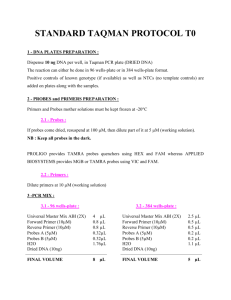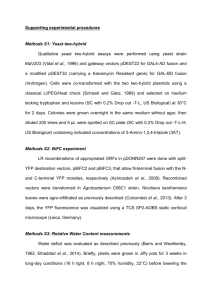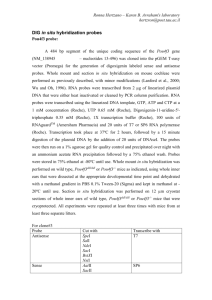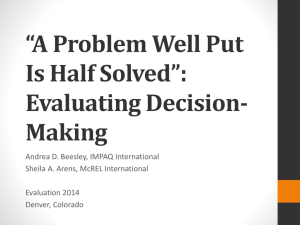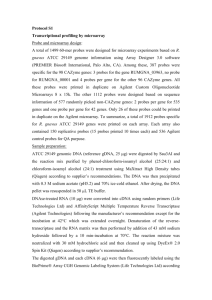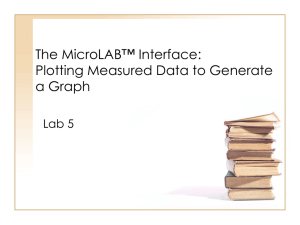Neuroimaging the Serial Position Curve
advertisement
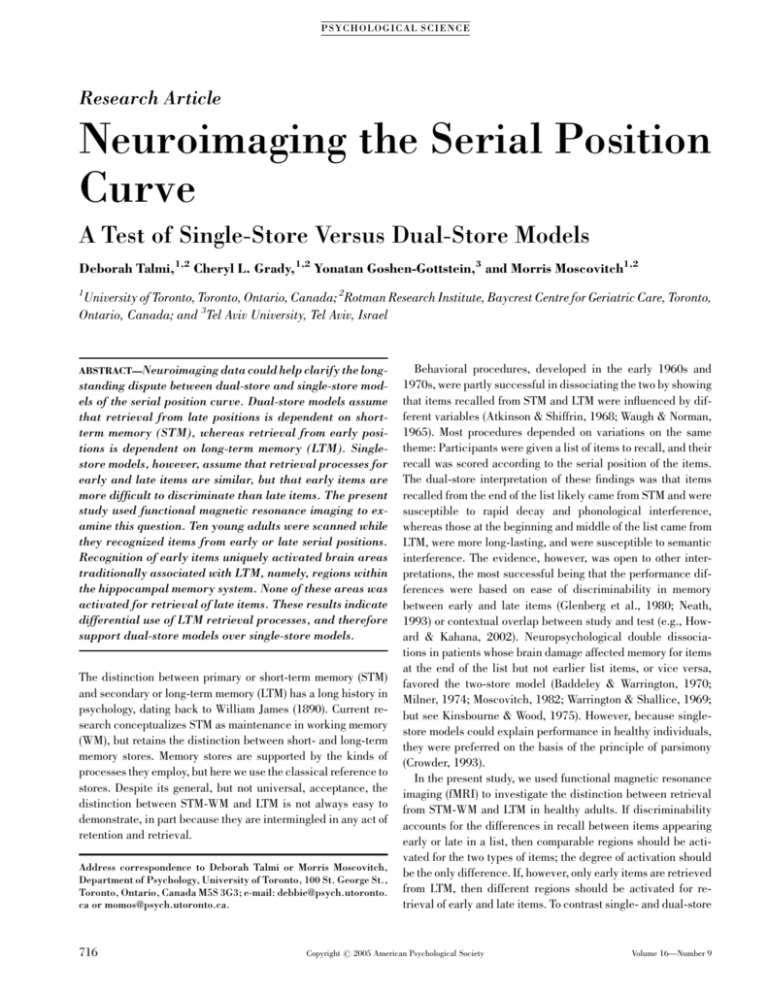
P SY CH OL OG I C AL S CIE N CE Research Article Neuroimaging the Serial Position Curve A Test of Single-Store Versus Dual-Store Models Deborah Talmi,1,2 Cheryl L. Grady,1,2 Yonatan Goshen-Gottstein,3 and Morris Moscovitch1,2 University of Toronto, Toronto, Ontario, Canada; 2Rotman Research Institute, Baycrest Centre for Geriatric Care, Toronto, Ontario, Canada; and 3Tel Aviv University, Tel Aviv, Israel 1 ABSTRACT—Neuroimaging data could help clarify the long- standing dispute between dual-store and single-store models of the serial position curve. Dual-store models assume that retrieval from late positions is dependent on shortterm memory (STM), whereas retrieval from early positions is dependent on long-term memory (LTM). Singlestore models, however, assume that retrieval processes for early and late items are similar, but that early items are more difficult to discriminate than late items. The present study used functional magnetic resonance imaging to examine this question. Ten young adults were scanned while they recognized items from early or late serial positions. Recognition of early items uniquely activated brain areas traditionally associated with LTM, namely, regions within the hippocampal memory system. None of these areas was activated for retrieval of late items. These results indicate differential use of LTM retrieval processes, and therefore support dual-store models over single-store models. The distinction between primary or short-term memory (STM) and secondary or long-term memory (LTM) has a long history in psychology, dating back to William James (1890). Current research conceptualizes STM as maintenance in working memory (WM), but retains the distinction between short- and long-term memory stores. Memory stores are supported by the kinds of processes they employ, but here we use the classical reference to stores. Despite its general, but not universal, acceptance, the distinction between STM-WM and LTM is not always easy to demonstrate, in part because they are intermingled in any act of retention and retrieval. Address correspondence to Deborah Talmi or Morris Moscovitch, Department of Psychology, University of Toronto, 100 St. George St., Toronto, Ontario, Canada M5S 3G3; e-mail: debbie@psych.utoronto. ca or momos@psych.utoronto.ca. 716 Behavioral procedures, developed in the early 1960s and 1970s, were partly successful in dissociating the two by showing that items recalled from STM and LTM were influenced by different variables (Atkinson & Shiffrin, 1968; Waugh & Norman, 1965). Most procedures depended on variations on the same theme: Participants were given a list of items to recall, and their recall was scored according to the serial position of the items. The dual-store interpretation of these findings was that items recalled from the end of the list likely came from STM and were susceptible to rapid decay and phonological interference, whereas those at the beginning and middle of the list came from LTM, were more long-lasting, and were susceptible to semantic interference. The evidence, however, was open to other interpretations, the most successful being that the performance differences were based on ease of discriminability in memory between early and late items (Glenberg et al., 1980; Neath, 1993) or contextual overlap between study and test (e.g., Howard & Kahana, 2002). Neuropsychological double dissociations in patients whose brain damage affected memory for items at the end of the list but not earlier list items, or vice versa, favored the two-store model (Baddeley & Warrington, 1970; Milner, 1974; Moscovitch, 1982; Warrington & Shallice, 1969; but see Kinsbourne & Wood, 1975). However, because singlestore models could explain performance in healthy individuals, they were preferred on the basis of the principle of parsimony (Crowder, 1993). In the present study, we used functional magnetic resonance imaging (fMRI) to investigate the distinction between retrieval from STM-WM and LTM in healthy adults. If discriminability accounts for the differences in recall between items appearing early or late in a list, then comparable regions should be activated for the two types of items; the degree of activation should be the only difference. If, however, only early items are retrieved from LTM, then different regions should be activated for retrieval of early and late items. To contrast single- and dual-store Copyright r 2005 American Psychological Society Volume 16—Number 9 D. Talmi et al. models best, we focused on the area most clearly associated with LTM processes—the hippocampal memory system in the medial temporal lobe (MTL; Milner, 1974; Schacter & Wagner, 1999). Dual-store models predict that only retrieval of early items would activate this region, whereas single-store models predict that retrieval of early and late items would be differentiated quantitatively, by the degree of MTL activation. In contrast, both models could explain similarity or difference in the activation of areas associated with STM-WM. Single-store models assume similarity, but if differences were found, differential difficulty could account for them. Dual-store models assume that only late items are retrieved directly from STM-WM, but the reciprocity between LTM and STM-WM in most dual-store models implies that early items would activate regions associated with STM-WM as well, because they need to be retrieved from LTM into STMWM before a response is selected (Fletcher & Henson, 2001). The one prior attempt to examine the neural substrate underlying the classic serial position effects (Zhang et al., 2003) focused on serial STM. The use of eight-digit subspan lists did not allow the authors to detect any differences between retrieval of early and late list items. Interpretation of the results is further complicated by the fact that participants recalled items in response to a serial position cue. Previous attempts to compare the brain regions involved in retrieval of items encoded at different points in time have typically contrasted a task that requires retrieval from LTM with a WM task. Consequently, task has been confounded with time of encoding. For example, Cabeza, Dolcos, Graham, and Nyberg (2002) compared recognition of words learned before the neuroimaging phase with recognition of the identity and location of words presented a few seconds prior to test. Ranganath and D’Esposito (2001; Ranganath, Johnson, & D’Esposito, 2000) had a tighter comparison between recognition of a set of faces studied minutes earlier and recognition of a single face presented a few seconds earlier and maintained in WM. The results of studies that have attempted to compare retrieval from LTM and WM are inconsistent. Although Cabeza et al. found that different areas in the prefrontal cortex (PFC) were activated in WM and LTM tasks, both Braver et al. (2001) and Ranganath et al. found similar PFC activations for the two tasks. With regard to MTL activations, results are again mixed. Cabeza et al. found hippocampal and parahippocampal activation for both WM and LTM tasks. Ranganath and D’Esposito, however, found hippocampal activation for WM maintenance, but not encoding or recognition, and parahippocampal activation for encoding and recognition. In the present experiment, participants studied a list of words and at test were presented with a single probe word, which could be either old or new. The critical comparison was between activation to old probes from the beginnings of the lists (early probes) and activation to old probes from the ends of the lists (late probes), thereby replicating behavioral serial position procedures in a neuroimaging study. Volume 16—Number 9 This single-probe recognition task yields behavioral results similar to those of the more traditional recall tasks (e.g., Monsell, 1978; Neath, 1993). Item presentation, interstimulus interval (ISI), and retention interval (RI) were purposefully short to discourage rehearsal, which could allow participants to retrieve even early list items from STM-WM (e.g., Zhang et al., 2003) and confound the comparison between early and late list items because primarily early items would be rehearsed. Successful prevention of rehearsal would be evident by elimination of the primacy effect (Glanzer & Cunitz, 1966). Our study lists included 12 items each, which exceeds STM-WM capacity (Tulving & Colotla, 1970). Therefore, dual-store models would predict LTM involvement in the recognition of the early probes, reflected in MTL activation, but not in the recognition of the late probes. Single-store models, in contrast, would predict only a quantitative, not a qualitative, difference between the activations for early and late probes. METHOD Participants Ten right-handed adults (4 males) between the ages of 20 and 25 years participated in the experiment. Participants received three 1-hr training sessions. Each training session included 120 lists (described in the next paragraph). Each serial position was probed five times. Half of the probes were new, and half were old. To ensure a sufficient number of correct responses during scanning, we scanned only participants with accuracy above 80% in the second training session. Materials To create trial-unique lists, we used a large pool of 2,890 words four to eight letters long. The words were divided into a training pool (frequency range of 5–55,245 per 100 million, according to British National Corpus, n.d.) and a scan pool (frequency range of 35–31,230 per 100 million). Words were sampled without replacement from the training pool, but were returned to the pool at the end of each training session. During the scanning session, all words were sampled without replacement from the scan pool. Behavioral Procedure The scan session included seven 596-s runs. Each run was divided into two consecutive blocks. Each block consisted of 9 trials: 7 memory trials and 2 control trials (see the next paragraph). Memory trials included the following: 2 trials with early probes (from Positions 1 and 2), 2 trials with late probes (from Positions 11 and 12), 2 trials with new probes, and 1 trial with a randomly sampled midlist probe (from Positions 3–10). All trial types were 32 s long, and trial types were randomly mixed within each block. A run began with a fixation point (‘‘1’’) presented for 18 s and then an asterisk presented for 2 s.The asterisk 717 Imaging the Serial Position Curve signaled the first trial. On each trial, an asterisk was presented for 1 s, and then 12 words were presented consecutively. Each word was presented for 800 ms; the ISI was 400 ms. The last word was followed by a 750-ms blank RI and then a 250-ms visual mask made of nonalphanumeric characters. The probe word was then presented for 1,500 ms. During this period, participants indicated whether the probe was an old word from the preceding list or a new word; they responded by using the index or middle finger of the right hand to press one of two keys in a Lumitouch response box (Lightwave Medical Industries, Burnaby, British Columbia, Canada; the correspondence of keys to fingers alternated across participants). After offset of the probe, the screen was blank for 14.5 s, after which a 2-s asterisk signaled that the next trial would begin. The only difference between the experimental and the control trials was that participants saw the words ‘‘old’’ and ‘‘new,’’ instead of novel words. ‘‘Old’’ and ‘‘new’’ alternated randomly during list presentation, and the probe was one of these two words. Participants pressed the corresponding key when they saw the probe just as they did in experimental trials (i.e., they pressed the ‘‘old’’ key when they saw the word ‘‘old’’ and the ‘‘new’’ key when they saw the word ‘‘new’’). Thus, the control trials included the same components as the experimental trials, except the intentional encoding of novel words and the recognition memory test. Therefore, the comparison between memory trials and control trials facilitated the isolation of the memory component. Words were presented in black, 24-point Times New Roman font at the center of a gray screen. Participants were instructed to read the words silently during both experimental and control trials. Participants practiced the task in the scanner before scanning began. After the first 3 subjects were scanned, we decided to include a WM span measure to address the potential concern that our participants were able to retrieve the early probes from WM. Following the third training session, participants performed computerized digit span and word span tasks (following Wechsler, 1987). Words for the word span task were not significantly different in frequency from the words in the scan pool, p > .10. Participants had a span of six to eight digits and four to five words; these results clearly show that the participants could not have retrieved the early probes from WM. with spiral readout, off-line gridding, and reconstruction (Lai & Glover, 1998; TR 5 2,000 ms; TE 5 40 ms; flip angle 5 801, 64 64 effective acquisition matrix). For each participant, standard volumetric anatomical MRI was performed before functional scanning by using a standard three-dimensional T1weighted pulse sequence (repetition time, TR 5 12.4 ms, TE 5 5.4 ms, flip angle 5 351, 22 16.5 field of view, 256 192 acquisition matrix, 124 axial slices 1.4 mm thick). Images of brain activation were computed and overlaid on anatomic images by using the Analysis of Functional NeuroImaging (AFNI) program (Cox, 1996). Time series data were spatially co-registered to correct for head motion by using a three-dimensional Fourier transform interpolation and detrended to a constant reference scan by using a fifth-order polynomial. Because our hypothesis concerned retrieval processes, we examined only activity beginning with the TR in which the probe was presented. AFNI was used to deconvolve the hemodynamic response function on a voxel-wise basis from the time series data to interpret the activations associated with the experimental conditions. The best linear least-squares fit was calculated for the following model parameters: constant baseline, linear trend in time series, and BOLD response deviation from baseline for each probe type (early, late, new, control). This fit of the parameters produced an estimate of the hemodynamic response, relative to fixation, for the images zero to six TRs after probe onset for each condition. This analysis produced four activation images per participant. These were then transformed into Talairach coordinates (Cox, 1996; Talairach & Tournoux, 1988) and smoothed with a Gaussian filter of 6 mm full width at half maximum to increase the signal-to-noise ratio. The latter step was performed to facilitate the subsequent group analysis. Group analysis consisted of a mixed-effect, voxel-wise twofactor analysis of variance (ANOVA) with probe type as a withinsubjects factor. For the comparison between probe types, the statistical cutoff was set at p < .005, uncorrected. For the wholebrain analysis, the minimum cluster size was 2 original voxels (90 mm3). To assess hippocampal activity further, we traced the hippocampus bilaterally on each participant’s structural images using known anatomical boundaries and counted the number of voxels active above threshold in this region of interest (ROI). Right hippocampal activations did not differ between conditions, so only left hippocampal activations are reported here. RESULTS fMRI Procedure Participants’ regional cerebral activity was assessed using a 1.5T Sigma MRI scanner with a standard head coil (CV/i hardware, LX8.3 software; General Electric Medical Systems, Waukesha, WI). Functional imaging was performed to measure brain activation by means of the blood-oxygenation-level-dependent (BOLD) effect (Ogawa, Lee, Kay, & Tank, 1990). Twenty-six axial slices 5 mm thick were obtained. Functional scans were obtained by using a single-shot T2n-weighted pulse sequence 718 Behavioral Results The effect of serial position (early vs. middle vs. late probes) on latency was significant, F(2, 18) 5 30.0, p < .001, Cohen’s f 5 1.82, with a significant linear trend, p < .001, f 5 3.12 (Fig. 1b). The effect of serial position on accuracy (percentage of items correctly recognized as old) was also significant, F(2, 18) 5 18.59, p < .001, f 5 1.43, with significant linear, p < .001, f 5 2.12, and quadratic, p < .05, f 5 .90, trends (see Fig. 1a). Volume 16—Number 9 D. Talmi et al. Fig. 1. Accuracy (a) and latency (b) for early, middle, and late probes. Error bars represent standard errors. The absence of a primacy effect shows that we succeeded in preventing rehearsal. The false alarm rate was low (M 5 9.6%, SD 5 8.75%). fMRI Results Only trials on which responses were correct were included in the analyses, which compared recognition of early versus late probes, recognition of old probes (hits) versus new probes (correct rejections), and recognition of old probes versus control probes. Although increased activation for hits over correct rejections indicates that a region may be responsive to retrieval success, this involvement may be masked if the same region is also responsive to encoding processes, which are expected to be higher for new than for old probes. Therefore, in comparing recognition of old versus new probes, we separated old probes into two groups on the basis of serial position and conducted two comparisons: early old probes versus new probes and late old probes versus new probes. Encoding activation would affect both of these comparisons equally, so the issue of encoding activation could be avoided by focusing on the difference between these two comparisons. Although the other comparisons all involved trials that included a similar encoding component, which was therefore subtracted out, old-probe trials differed from control trials with respect to both encoding and retrieval. As in the case of old-probe versus new-probe trials, we again conducted two comparisons—early-probe trials versus control trials and late-probe trials versus control trials—and focused on the difference between them. Because encoding activation was Volume 16—Number 9 identical for early and late probes, any difference between the two comparisons must be attributed to probe-recognition processes. The complete report of all results is posted on-line at http://www.psych.utoronto.ca/Neuropsychologylab/talmi.html. Here we focus on a subset of the findings. The comparisons revealed that MTL was more active for early probes than for late probes and control probes (Fig. 2). Relative to late probes, early probes activated a left MTL region extending from the hippocampus, through the perirhinal cortex (Brodmann’s area, BA, 36), to the fusiform gyrus (peak at x 5 37, y 5 35, z 5 12; Z 5 3.18; 215 mm3). The same pattern of activation was evident when early probes, but not late probes, were compared with control probes; early probes activated the left hippocampus, extending to the left perirhinal cortex and the fusiform gyrus (peak at x 5 32, y 5 28, z 5 9; Z 5 4.14; 489 mm3), as well as the entorhinal cortex (BA 28/35) bilaterally (left peak: x 5 17, y 5 27, z 5 6; Z 5 3.71; 144 mm3; right peak: x 5 20, y 5 30, z 5 7; Z 5 4.06; 130 mm3). Using a more lenient threshold ( p < .01), we also found left hippocampal activation in the comparison of early-probe and new-probe trials. However, even with this threshold, late probes did not activate the MTL more than did the control probes or the new probes. To explore further the activation in the left hippocampus, we conducted an ROI analysis of this area (Fig. 3). There was a marginally significant difference in the number of voxels active above threshold across the four conditions, F(3, 27) 5 2.43, p 5 .087. Planned contrasts showed that the number of active voxels was higher for early probes than for late probes, p 5 .01 (9 participants showed this pattern) and marginally higher for early probes than for the control probes, p 5 .076 (7 participants showed this pattern). Post hoc t tests showed that the number of active voxels was also higher for early probes than for new probes, t(9) 5 2.58, p < .05 (7 participants showed this pattern). There were no significant differences between the activations for late probes and control probes, t(9) 5 1.02, p > .10, or between the activations for late and new probes, t(9) 5 0.10, p > .10. It is important to note that the number of active voxels was numerically lower for late probes than for control probes or new probes; this shows that the lack of a significant effect was not due to low statistical power. The activation for the control and late-probe trials likely reflects registering the probe, which took place in both control and memory trials. Compared with late probes or control probes, early probes activated a large network of memory-related areas in addition to the MTL. In comparison with late probes, early probes showed greater activation in several PFC regions, including the right and left ventral and dorsolateral PFC, left precuneus, posterior cingulate gyrus and retrosplinial cortex, and thalamus. In comparison with control probes, early probes activated the right ventral and left dorsolateral PFC, as well as the left precuneus and right and left thalamus. The right inferior parietal lobule (IPL) was the only area more active for late probes than for early 719 Imaging the Serial Position Curve Fig. 2. Sagittal views of the brain showing activation for early probes relative to late probes and control probes. White and black areas represent functional activations for the early-probe condition and for the comparison condition, respectively. The first two panels show the contrast between early and late probes, with arrows pointing to the hippocampus (a) and to the perirhinal cortex (b). The next two panels show the contrast between the early-probe condition and the control condition, with arrows pointing to the medial temporal lobe activation, spanning the hippocampus and perirhinal cortex (c), and to the entorhinal cortex (d). probes. Late probes did not activate any area more than did control probes. Relative to new probes, both early and late probes activated the left IPL and left premotor cortex, but different regions within these structures; activation was more medial for early probes than for late probes. Comparisons with new probes also showed Fig. 3. Percentage of voxels active above threshold in the left hippocampus region of interest for early, late, new, and control probes. Error bars represent standard errors. 720 that early probes activated the right ventral PFC and the right and left precuneus, and late probes activated the right IPL. DISCUSSION According to dual-store models, only early probes require retrieval of stored information from LTM into STM-WM. STM-WM content then determines response selection. Thus, these models predict that MTL would be activated only for early probes, whereas regions associated with STM-WM would be activated for both types of probes. The results generally confirm these predictions. Only early probes activated areas traditionally associated with LTM retrieval for words, such as the left hippocampus (Golby et al., 2001; Schacter & Wagner, 1999; see Hermann et al., 1996, for lesion studies). Retrieval of both early and late probes activated areas associated with STM-WM, including frontal and parietal cortices. That different brain regions were implicated in retrieving early and late probes lends support to dual-store models of memory retrieval over single-store models. The main finding in this study is that relative to control probes or new probes, early probes, but not late probes, activated the left hippocampal memory system. Activation for late probes was numerically lower than activation for control probes, which Volume 16—Number 9 D. Talmi et al. makes it unlikely that lack of power could account for this finding. The diminution, indeed absence, of activation in MTL in the late-probe condition relative to the control or the new-probe condition is crucial evidence against single-store models, which predict at least some (above-control) level of MTL activation. In contrast to our study, others (Cabeza et al., 2002; Ranganath & D’Esposito, 2001) have demonstrated hippocampal activation in a WM task. That activation, however, was limited to the maintenance phase of the task, which can be construed as also drawing on LTM. The absence of a long maintenance phase in our task may explain why we did not obtain MTL activation in the late-probe (STM-WM) retrieval condition. As expected, the behavioral measures, accuracy and reaction time, showed differences between retrieval from early list positions and retrieval from late list positions. Accuracy differences do not pose a problem for our study, because we analyzed only trials with correct responses, and because the low false alarm rate indicated guessing was minimal. A potential confound in the present findings is that the differences between our critical memory conditions reflect differences in difficulty. The differences in performance in the two conditions, however, are inherent to our comparison of interest and occur in all other such studies (see Ranganath & D’Esposito, 2001, and Ranganath et al., 2000, for similar results); indeed, the serial position curve arises from them. Moreover, other data suggest that it is unlikely that increased MTL activation reflects task difficulty alone (Barch et al., 1997). Still, this issue needs to be investigated more directly in future research to see if it is possible to dissociate difficulty and mnemonic demands in single-probe recognition by using the difficulty manipulation of Barch et al. We predicted that STM-WM processes would be implicated in retrieval of both early and late probes, and the data are consistent with this prediction. A common set of regions was active regardless of the serial position of the probe when participants successfully retrieved an item. Correct recognition of early or late probes activated the premotor cortex and the IPL more than correct rejection of new items. These areas are typically associated with WM processes (Smith & Jonides, 1999). Additionally, recognition of early probes activated the right ventral PFC and the precuneus, regions also activated often in WM studies (D’Esposito et al., 1998). These activations, as well as dorsal PFC activations, were found in the comparison of early versus late probes. Our finding of some activation for late probes, but overall greater activation in these regions for early probes, may reflect the increased effort required to retrieve these items from LTM, as compared with retrieving those items already stored in STM-WM (Fletcher & Henson, 2001). These findings support the view that apart from the hippocampus and MTL, many of the structures associated with LTM retrieval, such as those in PFC, are domain-general structures that are implicated in other cognitive tasks to a greater or lesser extent (Moscovitch, 1992); this view has been corroborated by neuroimaging evidence (Nyberg et al., 2003). Volume 16—Number 9 The only region where activation was greater for late probes than early probes was the right IPL. Activation also was greater in IPL and the premotor cortex for late probes than for new probes, but activation in the late-probe condition and the control condition did not differ in any region. We speculate that participants matched both late and control probes to information in STM-WM: the words ‘‘old’’ or ‘‘new’’ in the case of the control trials and the most recent words in the case of late-probe trials. By definition, such matching could not occur for new probes. In short, the control condition resembled the late-probe condition too closely and likely masked some activation that might have been revealed with the use of a less tight control. Our study used a well-established paradigm in human cognitive psychology and added neuroimaging evidence to support the distinction between STM-WM and LTM processes. Molecular and pharmacological dissociations also support the independence of STM-WM and LTM processes (Izquierdo et al., 2002), but the time-frame and paradigm differences make generalization from those studies to ours difficult. Notably, in research with nonhuman animals, STM-WM typically is defined as encompassing a time frame of minutes to hours (Dudai, 2004; Izquierdo et al., 2002). Still, the distinction between STM-WM and LTM processes as reflected in the serial position curve has parallels in animal research: Items in early serial positions are forgotten more in rats with hippocampal lesions than animals with intact hippocampi; similarly, after a delay, intact animals forget only items from late serial positions (Kesner & Novak, 1982). From a theoretical standpoint, our investigation of the neural basis of serial position effects is particularly interesting because it can add crucial data to a long-standing dispute about the mechanisms underlying the retrieval of items encoded at different points in time. There is a curiously wide gap between the cognitive and the neuropsychological literature in this area. Although lesion and neuroimaging studies take dual-store models as their point of departure (Baddeley & Warrington, 1970; Fletcher & Henson, 2001; Kinsbourne & Wood, 1975; Milner, 1974; Moscovitch, 1982; Warrington & Shallice, 1969), the consensus in behavioral work over the past decade has increasingly shifted toward single-store models (Howard & Kahana, 2002; Neath, 1993, but see Davelaar, Goshen-Gottstein, Ashkenazi, Haarmann, & Usher, 2004). The present study originated from behavioral research on the serial position curve in general, and the recency effect in particular, and used neuroimaging tools to examine this behavioral effect. Our findings of a qualitative difference between retrieval of early and late probes support the dual-store models of the serial position curve. Although they support the dual-store models, our data still need to be reconciled with previous data that suggested STM is not useful to explain behavior (Crowder, 1993). The crucial finding that led behavioral research to shift from dual-store models to single-store models was the long-term recency effect 721 Imaging the Serial Position Curve (Bjork & Whitten, 1974), which is found under encoding conditions using filled ISIs, even after a long filled RI. Late list items cannot remain in STM-WM under these conditions, so some other mechanism is required to account for the long-term recency effect. Crowder contended that according to the parsimony principle, ‘‘the burden of evidence should be with those who say these two, similar recency effects [the short-term effect in immediate testing and the long-term recency effect] are mediated by different mechanisms’’ (p. 143). Our finding can be regarded as a positive response to his challenge. By showing that hippocampal activation is associated with early probes but not with late probes, we have demonstrated that a dual-store model best accounts for recency effects with immediate testing (short-term recency effects). However, we concur with Davelaar et al. (2004), who have suggested that, in addition, an LTM process is needed to account for long-term recency effects. Acknowledgments—The authors thank Jeremy B. Caplan, Marilyne Ziegler, and Simon J. Graham for helpful discussions and assistance. This research was supported by grants to C.L.G. (Canadian Institute of Health Research, MOP14036), D.T. (Ontario Graduate Scholarship), M.M. (Natural Sciences and Engineering Research Council) and Y.G.-G. (Israel Science Foundation, Grant 894-01). REFERENCES Atkinson, R.C., & Shiffrin, R.M. (1968). Human memory: A proposed system and its control processes. In K.W.S. Spence & J.T. Spence (Eds.), The psychology of learning and motivation (Vol. 2, pp. 89– 195). Oxford, England: Academic Press. Baddeley, A.D., & Warrington, E.K. (1970). Amnesia and the distinction between long- and short-term memory. Journal of Verbal Learning and Verbal Behavior, 9, 176–189. Barch, D.M., Braver, T.S., Nystrom, L.E., Forman, S.D., Noll, D.C., & Cohen, J.D. (1997). Dissociating working memory from task difficulty in human prefrontal cortex. Neuropsychologia, 35, 1373– 1380. Bjork, R.A., & Whitten, W.B. (1974). Recency-sensitive retrieval processes in long-term free recall. Cognitive Psychology, 6, 173– 189. Braver, T.S., Barch, D.M., Kelley, W.M., Buckner, R.L., Cohen, N.J., Miezin, F.M., Snyder, A.Z., Ollinger, J.M., Akbudak, E., Conturo, T.E., & Petersen, S. (2001). Direct comparison of prefrontal cortex regions engaged by working and long-term memory tasks. NeuroImage, 14, 48–59. British National Corpus. (n.d.). Retrieved July 4, 2004, from http:// www.natcorp.ox.ac.uk Cabeza, R., Dolcos, F., Graham, R., & Nyberg, L. (2002). Similarities and differences in the neural correlates of episodic memory retrieval and working memory. NeuroImage, 16, 317–330. Cox, R.W. (1996). AFNI: Software for analysis and visualization of functional magnetic resonance neuroimages. Computers and Biomedical Research, 29, 162–173. Crowder, R.G. (1993). Short-term memory: Where do we stand? Memory & Cognition, 21, 142–145. 722 Davelaar, E.J., Goshen-Gottstein, Y., Ashkenazi, A., Haarmann, H.J., & Usher, M. (2004). The demise of short-term memory revisited: Empirical and computational investigations of recency effects. Psychological Review, 112, 3–42. D’Esposito, M., Aguirre, G.K., Zarahn, E., Ballard, D., Shin, R.K., & Lease, J. (1998). Functional MRI studies of spatial and nonspatial working memory. Cognitive Brain Research, 7, 1–13. Dudai, Y. (2004). The neurobiology of consolidations, or, how stable is the engram? Annual Review of Psychology, 55, 51–86. Fletcher, P.C., & Henson, R.N. (2001). Frontal lobes and human memory: Insights from functional neuroimaging. Brain, 124, 849–881. Glanzer, M., & Cunitz, A.R. (1966). Two storage mechanisms in free recall. Journal of Verbal Learning and Verbal Behavior, 5, 351–360. Glenberg, A.M., Bradley, M.M., Stevenson, J.A., Kraus, T.A., Tkachuk, M.J., Gretz, A.L., Fish, J.H., & Turpin, B.A.M. (1980). A two-process account of long-term serial position effects. Journal of Experimental Psychology: Human Learning and Memory, 6, 355–369. Golby, A.J., Poldrack, R.A., Brewer, J.B., Spencer, D., Desmond, J.E., Aron, A.P., & Gabrieli, J.D.E. (2001). Material-specific lateralization in the medial temporal lobe and prefrontal cortex during memory encoding. Brain, 124, 1841–1854. Hermann, B.P., Seidenberg, M., Wyler, A., Davies, K., Christeson, J., Moran, M., & Stroup, E. (1996). The effects of human hippocampal resection on the serial position curve. Cortex, 32, 323–334. Howard, M.W., & Kahana, M.J. (2002). A distributed representation of temporal context. Journal of Mathematical Psychology, 46, 269–299. Izquierdo, L.A., Barros, D.M., Vianna, M.R., Coitinho, A., deDavis e Silva, T., Choi, H., Moletta, B., Medina, J.H., & Izquierdo, I. (2002). Molecular pharmacological dissection of short- and longterm memory. Cellular and Molecular Neurobiology, 22, 269–287. James, W. (1890). The principles of psychology. London: Macmillan. Kesner, R.P., & Novak, J.M. (1982). Serial position curve in rats: Role of the dorsal hippocampus. Science, 218, 173–175. Kinsbourne, M., & Wood, F. (1975). Short-term memory processes and the amnesic syndrome. In J.A. Deutsch (Ed.), Short-term memory (pp. 257–291). New York: Academic Press. Lai, S., & Glover, G.H. (1998). Three-dimensional spiral fMRI technique: A comparison with 2D spiral acquisition. Magnetic Resonance in Medicine, 39, 68–78. Milner, B. (1974). Hemispheric specialization: Scope and limits. In P.O. Schmitt & F.G. Worden (Eds.), The neurosciences: Third study program (pp. 75–89). Cambridge, MA: MIT Press. Monsell, S. (1978). Recency, immediate recognition memory, and reaction time. Cognitive Psychology, 10, 465–501. Moscovitch, M. (1982). Multiple dissociations of function in amnesia. In L.S. Cermak (Ed.), Human memory and amnesia (pp. 337–370). Hillsdale, NJ: Erlbaum. Moscovitch, M. (1992). Memory and working-with-memory: A component process model based on modules and central systems. Journal of Cognitive Neuroscience, 4, 257–267. Neath, I. (1993). Serial position effects in recognition. Memory & Cognition, 21, 689–698. Nyberg, L., Marklund, P., Persson, J., Cabeza, R., Forkstam, C., Petersson, K., & Ingvar, M. (2003). Common prefrontal activations during working memory, episodic memory, and semantic memory. Neuropsychologia, 41, 371–377. Ogawa, S., Lee, T.M., Kay, A.R., & Tank, D.W. (1990). Brain magnetic resonance imaging with contrast dependent on blood Volume 16—Number 9 D. Talmi et al. oxygenation. Proceedings of the National Academy of Sciences, USA, 87, 9868–9872. Ranganath, C., & D’Esposito, M. (2001). Medial temporal lobe activity associated with active maintenance of novel information. Neuron, 31, 865–873. Ranganath, C., Johnson, M.K., & D’Esposito, M. (2000). Left anterior prefrontal activation increases with demands to recall specific perceptual information. Journal of Neuroscience, 20, RC108. Schacter, D.L., & Wagner, A.D. (1999). Medial temporal lobe activations in fMRI and PET studies of episodic encoding and retrieval. Hippocampus, 9, 7–24. Smith, E.E., & Jonides, J. (1999). Storage and executive processes in the frontal lobes. Science, 283, 1657–1661. Talairach, J., & Tournoux, P. (1988). Co-planar stereotaxic atlas of the human brain: Three-dimensional proportional system. New York: Thieme Medical. Volume 16—Number 9 Tulving, E., & Colotla, V.A. (1970). Free recall of trilingual lists. Cognitive Psychology, 1, 86–98. Warrington, E.K., & Shallice, T. (1969). The selective impairment of auditory verbal short-term memory. Brain, 92, 885–896. Waugh, N.C., & Norman, D.A. (1965). Primary memory. Psychological Review, 72, 89–104. Wechsler, D. (1987). The Wechsler Memory Scale–Revised. New York: Psychological Corp., Harcourt Brace Jovanovich. Zhang, D.R., Li, Z.H., Chen, X.C., Wang, Z.X., Zhang, X.C., Meng, X.M., He, S., & Hu, X.P. (2003). Functional comparison of primacy, middle and recency retrieval in human auditory short-term memory: An event-related fMRI study. Brain Research: Cognitive Brain Research, 16, 91–98. (RECEIVED 3/25/04; REVISION ACCEPTED 11/17/04; FINAL MATERIALS RECEIVED 12/2/04) 723

